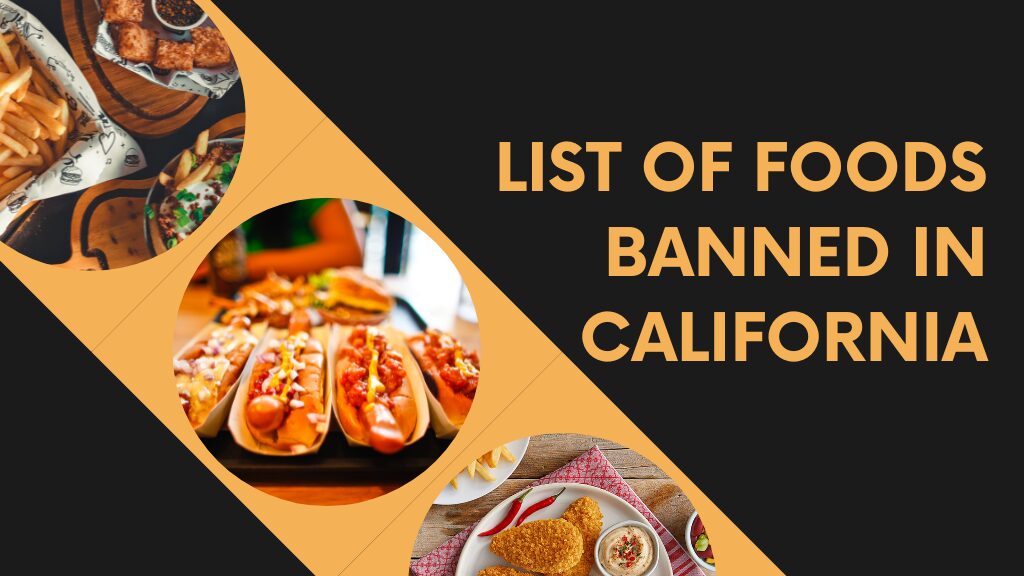California is often seen as a pioneer in health and wellness trends, setting standards that the rest of the nation eventually follows. From climate policies to environmental regulations, the Golden State has a long history of leading reforms that prioritize the well-being of its citizens. One of the most recent and widely discussed steps is the creation of the List of Foods Banned in California, which restricts certain items and additives that have been linked to potential health risks. This decision has sparked national debate, as it forces food manufacturers to reconsider their ingredients and has made consumers more aware of what is truly inside the products they consume every day.
The significance of this move cannot be understated. Many of the foods on California’s banned list are not exotic imports or rare delicacies but rather common snacks, baked goods, and beverages that millions of Americans have enjoyed for decades.
Why Are Foods Banned in California?
California bans foods when scientific research shows that certain ingredients or additives pose risks to human health. These risks may include hyperactivity in children, hormone disruption, reproductive harm, or even cancer. While federal agencies like the FDA have been slow to update their food safety guidelines, California has acted independently, setting higher standards for consumer safety. This proactive approach not only raises awareness but also forces manufacturers to reformulate products for compliance, which often benefits consumers nationwide.
The Comprehensive List of Foods Banned in California
Red Dye No. 3
Red Dye No. 3 has long been used to brighten candies, pastries, and beverages, but research has linked it to behavioral problems in children and potential thyroid cancer in lab animals. Though once common in everyday treats, California banned it to protect vulnerable groups, especially children who consume brightly colored foods more often. With the ban in place, many manufacturers are switching to fruit and vegetable-based colorants as safer alternatives.
Potassium Bromate
Potassium bromate, a flour additive, improves dough strength and bread volume. Despite its usefulness, it has been identified as a possible carcinogen after studies linked it to kidney and thyroid tumors in animals. While some countries banned it years ago, it remained legal in the U.S. until California acted. Now, bakeries and food brands are moving toward unbromated flour and safer dough conditioners, setting an example for the rest of the country.
Brominated Vegetable Oil (BVO)
BVO is commonly found in citrus-flavored sodas and energy drinks, keeping flavor evenly mixed. However, long-term exposure has been tied to thyroid problems, memory issues, and even reproductive harm. Some consumers reported symptoms such as skin rashes and headaches after heavy consumption. With California’s ban, major beverage companies are reformulating drinks using safer natural emulsifiers like gum acacia and glycerol esters.
Propylparaben
Propylparaben, used as a preservative in snack bars, baked goods, and processed foods, helps extend shelf life by preventing mold growth. However, it disrupts hormones and has been linked to reduced fertility in animal studies. California banned it to safeguard reproductive health and promote cleaner alternatives. Food makers are now experimenting with natural preservation methods, including plant extracts and improved packaging technology.
Titanium Dioxide
Titanium dioxide gives candies and chewing gum their bright, appealing white color. Unfortunately, research suggests it can damage DNA and increase the risk of cancer, leading the European Union to ban it in 2022. California followed suit, removing it from the shelves. Many companies are now turning to mineral-based alternatives or naturally derived whitening agents to maintain visual appeal without compromising health.
Azodicarbonamide (ADA)
Azodicarbonamide, often called the “yoga mat chemical,” is a dough conditioner used in breads and baked goods to improve texture. Though approved at low levels, studies suggest it may cause respiratory issues and has been linked to increased cancer risk in animals. Several major fast-food chains removed it after public backlash, and California officially restricted its use. This reinforces the demand for breads made with natural fermentation methods.
Butylated Hydroxyanisole (BHA)
BHA is a synthetic antioxidant used to preserve fats and oils in snack foods, cereals, and frozen meals. While effective at preventing rancidity, the compound has been identified as a potential carcinogen by the National Toxicology Program. California banned its use, pushing companies toward safer natural antioxidants like vitamin E and rosemary extract. Consumers benefit from fresher, less chemically treated products.
Butylated Hydroxytoluene (BHT)
Closely related to BHA, BHT is another preservative used in cereals, chips, and packaged snacks. While some studies show it may have antioxidant benefits, others suggest it can cause liver enlargement and disrupt hormones. California included it in its banned list to err on the side of caution. Food makers are now shifting toward natural preservation techniques and clean-label formulations.
Brominated Flame Retardant Residues in Drinks
Some citrus-flavored beverages were found to contain traces of brominated flame retardant compounds due to their use of brominated vegetable oil. These residues raised alarms because of their potential impact on neurological and reproductive health. California’s decision to prohibit such additives ensures that consumers can enjoy refreshing drinks without hidden chemical risks.
The Broader Impact of California’s Ban
Influence on National Food Standards
When a state as large as California bans an additive, national companies rarely create separate formulas just for one region. Instead, they often reformulate products for the entire U.S. market. This means the restrictions don’t just affect Californians they end up reshaping food standards across the country.
Consumer Awareness and Demand for Transparency
The bans have made consumers more aware of what goes into their food. Shoppers are increasingly reading labels and demanding clean, transparent ingredient lists. This consumer-driven push for healthier options is transforming the food industry faster than legislation alone.
How the Ban Affects Restaurants and Retailers
Restaurants, bakeries, and retailers in California have had to adjust their recipes and sourcing strategies to comply with the new rules. While some feared this would drive up costs, many have found that offering cleaner, additive-free foods actually boosts customer trust and brand loyalty. Consumers are more willing to support businesses that prioritize their health.
The Role of Federal Regulations
The FDA has historically moved slowly when it comes to banning or restricting food additives, which is why California stepped in. The state’s proactive measures often serve as a model for others, and it is likely that more states will eventually follow California’s lead in tightening food safety laws.
Future Foods That May Face Scrutiny
Experts predict that more artificial colors, preservatives, and emulsifiers may soon be under review. As scientific studies uncover new evidence of health risks, California’s banned list will likely grow. This reflects a global shift toward cleaner, more natural food systems.
FAQs
Why did California ban certain foods?
The state banned foods and additives linked to cancer, hormone disruption, and behavioral problems to prioritize public health.
Are these bans nationwide?
No, they apply only in California, but companies often change their recipes nationwide to streamline production.
Will food become more expensive because of the ban?
Some reformulated products may cost slightly more initially, but competition and demand for clean foods usually stabilize prices over time.
How can I avoid harmful additives if I live outside California?
Check ingredient labels and look for “no artificial colors,” “preservative-free,” or clean-label certifications when shopping.
Will more foods be banned in the future?
Yes, experts believe more additives will be scrutinized and possibly banned as new research emerges.
Conclusion
The List of Foods Banned in California is far more than a regional regulation—it is a powerful statement about the importance of health and transparency in the food industry. By banning additives such as Red Dye No. 3, potassium bromate, brominated vegetable oil, propylparaben, titanium dioxide, BHA, BHT, and others, California has chosen to put consumer well-being ahead of convenience. These measures are transforming how food is manufactured, sold, and consumed, not only within the state but across the nation.
For consumers, the ban means greater protection and the assurance that harmful chemicals are being phased out of daily diets. For companies, it is a challenge to innovate and offer safer alternatives that still satisfy consumer demand. Ultimately, this bold step ensures that food safety is not left to chance but is actively pursued, setting the stage for a healthier future. California’s leadership in this area may well become the blueprint for national reform, proving once again that the Golden State is at the forefront of change when it comes to protecting public health.





